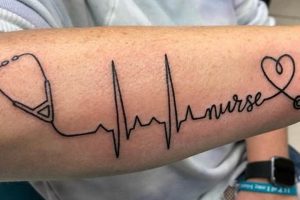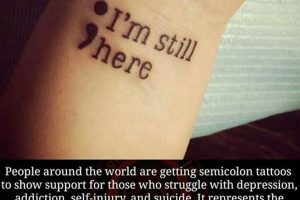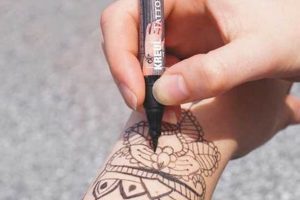Permanent body art inspired by the horror film genre offers a powerful medium for self-expression. These designs can range from subtle homages to iconic characters or monsters to elaborate depictions of memorable scenes or symbolic imagery. Examples include portraits of classic figures like Freddy Krueger or Jason Voorhees, stylized depictions of terrifying creatures, or minimalist representations of significant objects or locations from popular films.
Choosing this form of artistic representation allows enthusiasts to display their appreciation for the genre’s artistry, storytelling, and psychological impact. It provides a visual shorthand for shared cultural experiences and can serve as a conversation starter among like-minded individuals. Furthermore, the historical evolution of horror cinema, with its shifting focus on different fears and societal anxieties, provides a rich tapestry of visual inspiration spanning decades of filmmaking.
This exploration delves further into the varied stylistic approaches, popular themes, and practical considerations involved in selecting and executing impactful designs derived from the world of horror cinema.
1. Iconic Imagery
Iconic imagery plays a crucial role in horror-themed tattoos, instantly conveying a film’s essence and evoking specific emotions. These instantly recognizable symbols act as visual shorthand, communicating complex narratives and thematic elements through a single, powerful image. Careful selection of these potent symbols ensures a tattoo resonates deeply with both the wearer and viewers familiar with the source material.
- Masks
Masks, frequently employed in horror films to conceal or distort identity, serve as powerful symbols of fear and anonymity. Examples include the hockey mask of Jason Voorhees (Friday the 13th), the Ghostface mask from Scream, or Michael Myers’s inexpressive visage in Halloween. In tattoo form, these masks represent not only the specific film but also broader themes of hidden identity, unpredictable violence, and the unsettling nature of the unknown.
- Weapons
Certain weapons become inextricably linked to specific horror franchises and their antagonists. Freddy Krueger’s glove with bladed fingers (A Nightmare on Elm Street), the chainsaw wielded by Leatherface (The Texas Chain Saw Massacre), or Pinhead’s hooks and chains (Hellraiser) are prime examples. Tattoos featuring these weapons symbolize the destructive power, specific methods, and unique terror associated with each character.
- Creatures
The distinct silhouettes of iconic creatures immediately conjure specific films and their associated fears. The Xenomorph from Alien, the Predator’s bio-mask, or the creature from The Thing exemplify this. Depicting these creatures in a tattoo can represent the primal fears they embody, such as parasitic invasion, relentless hunting, or body horror.
- Locations
Specific locations can also become iconic within the horror genre, representing a locus of terror and dread. The Overlook Hotel from The Shining, the Bates Motel from Psycho, or Camp Crystal Lake from Friday the 13th are recognizable settings imbued with a history of violence. Tattoos featuring these locations symbolize the inescapable nature of fear and the power of place in shaping a narrative.
By carefully selecting iconic imagery, individuals can create tattoos that serve as enduring tributes to their favorite horror films, effectively encapsulating the essence of fear, suspense, and the macabre. These images transcend mere fandom, becoming potent symbols that resonate with the genre’s enduring power to explore the darker aspects of the human psyche.
2. Stylized Portraits
Stylized portraits offer a unique approach to horror movie tattoo ideas, allowing for personalized interpretations of iconic characters. Moving beyond straightforward depictions, stylized portraits capture the essence of these figures through artistic expression, emphasizing specific features, and employing diverse techniques to convey a particular mood or aesthetic.
- Exaggerated Features
Exaggerating specific features amplifies the unsettling qualities of horror characters. A widened, manic grin on the Joker (DC Comics), elongated claws on Freddy Krueger (A Nightmare on Elm Street), or intensely piercing eyes on Michael Myers (Halloween) heightens their terrifying presence. This artistic choice intensifies the character’s defining traits, creating a visually striking and memorable tattoo.
- Abstract Representations
Abstract representations allow for a more conceptual approach to character portrayal. Using geometric shapes, distorted lines, or fragmented imagery to represent Pennywise the Dancing Clown (IT) or the Babadook (The Babadook) can evoke a sense of unease and psychological disturbance. This technique prioritizes capturing the character’s psychological impact over precise physical likeness.
- Genre-Specific Aesthetics
Incorporating genre-specific aesthetics, like the stark contrast and heavy shadows of German Expressionism or the vibrant colors and exaggerated gore of Italian Giallo films, further stylizes the portrait. Applying these stylistic elements to a portrait of Nosferatu (Nosferatu) or Dario Argento’s iconic villains imbues the tattoo with a specific cinematic atmosphere.
- Incorporation of Symbolic Elements
Adding symbolic elements deepens the portrait’s narrative. Integrating imagery like ravens for Edgar Allan Poe’s characters or specific flowers associated with death for characters like Regan MacNeil (The Exorcist) adds layers of meaning. This technique enriches the visual narrative and provides further insight into the character’s motivations or fate.
By combining artistic interpretation with recognizable character elements, stylized portraits within horror tattoo designs provide a powerful means of personal expression. They allow individuals to showcase their appreciation for the genre while simultaneously celebrating the artistry and psychological depth of its iconic figures.
3. Genre-specific symbolism
Genre-specific symbolism adds layers of meaning to horror movie tattoo ideas, moving beyond mere character representation to explore deeper themes and cultural references within the genre. These symbols draw upon established conventions and visual language, enriching the tattoo’s narrative and resonating with those familiar with the specific genre’s tropes and historical context.
- Religious Iconography
Religious iconography, often subverted or juxtaposed with dark imagery, plays a significant role in horror, particularly within subgenres like demonic possession or cosmic horror. Inverted crosses, corrupted biblical passages, or distorted depictions of saints or angels, as seen in films like The Omen or The Exorcist, can represent the perversion of faith, the struggle against evil, or the blurring of boundaries between the sacred and the profane. These symbols add a layer of thematic complexity to tattoo designs.
- Occult Symbolism
Occult symbols, drawn from various esoteric traditions, frequently appear in horror films dealing with witchcraft, summoning rituals, or forbidden knowledge. Pentagrams, sigils, alchemical diagrams, or imagery associated with specific deities like Cthulhu (H.P. Lovecraft’s mythos) can represent the pursuit of forbidden power, the unleashing of dark forces, or the exploration of hidden realities. These symbols appeal to those fascinated by the mysteries of the occult and its representation within the horror genre.
- Folklore and Mythology
Folklore and mythology provide a rich source of symbolic imagery for horror tattoos. Creatures like werewolves, vampires, or mythological figures like the Grim Reaper carry pre-existing cultural baggage and symbolic weight. Incorporating these figures into a tattoo design can draw upon these established meanings, referencing universal themes of mortality, transformation, or the duality of human nature as explored in films like An American Werewolf in London or Dracula.
- Psychological Horror Tropes
Specific objects or visual motifs within psychological horror can serve as powerful symbolic representations of mental states or thematic concepts. Mirrors reflecting distorted realities, shadowy figures representing repressed trauma, or specific colors associated with madness or despair, as seen in films like The Shining or Repulsion, can convey complex psychological narratives within a tattoo design. These symbols allow for a more nuanced and personalized exploration of the genre’s themes.
By incorporating genre-specific symbolism, horror movie tattoo ideas transcend mere visual representation and become powerful statements about the wearer’s understanding and appreciation of the genre’s complexities. These symbols deepen the narrative potential of the tattoo, offering layers of interpretation and fostering a sense of shared recognition among those versed in the rich tapestry of horror cinema.
4. Blackwork and color palettes
Blackwork and strategic color palettes play a crucial role in realizing effective horror-themed tattoos. Blackwork, with its bold contrasts and potential for intricate detail, provides a strong foundation for many designs within the genre. Solid black ink creates striking silhouettes of monstrous figures, intricate depictions of decaying flesh, or ominous backgrounds that enhance the overall sense of dread. This technique effectively captures the dark, atmospheric nature of horror cinema. The use of heavy black ink can also evoke classic horror comic book aesthetics, appealing to fans of that medium. Examples include depictions of characters like Hellboy (Mike Mignola’s comic series) or Spawn (Image Comics), where blackwork defines their demonic forms.
Color, while used more sparingly in horror tattoos, serves to highlight specific elements and amplify the emotional impact. Deep reds and burgundies effectively represent blood and gore, enhancing the visceral nature of body horror or slasher films. Sickly greens and yellows can evoke themes of decay, disease, and otherworldly presence, as seen in depictions of zombies or Lovecraftian monsters. Strategic splashes of vibrant color against a predominantly black background can create a stark contrast, drawing the eye to specific details and intensifying their impact. The vibrant green of the Necronomicon Ex-Mortis (Evil Dead) against a black background, for instance, instantly communicates the book’s sinister power. Similarly, the unnatural yellow eyes of a demonic entity immediately establish a sense of otherworldly threat.
The interplay between blackwork and color palettes contributes significantly to the overall atmosphere and impact of a horror-themed tattoo. Careful consideration of these elements ensures the final design effectively captures the desired tone and visual style, whether emphasizing the stark terror of black and white horror classics or the visceral impact of more contemporary gore-filled imagery. Balancing these elements requires artistic skill and a deep understanding of the horror genre’s visual language, resulting in tattoos that resonate with both the wearer and viewers familiar with the source material’s specific aesthetic.
5. Placement and sizing
Placement and sizing are critical considerations in horror movie tattoo designs, impacting both the aesthetic appeal and the narrative effectiveness of the piece. The human body’s contours provide a dynamic canvas, and thoughtful placement can enhance the tattoo’s visual impact, creating an illusion of depth, movement, or integration with the body’s natural lines. A sprawling, detailed depiction of a creature from John Carpenter’s The Thing might benefit from placement across the back or chest, allowing for a greater sense of scale and visual impact. Conversely, a smaller, symbolic tattoo, such as the glyphs from Hellraiser, might be more effectively placed on the wrist or ankle, creating a sense of mystery and subtle menace. Incorrect placement can diminish a tattoo’s impact, rendering a detailed design cluttered or obscuring key elements.
Sizing also significantly influences the level of detail and overall impression. Intricate designs featuring characters like Pinhead (Hellraiser) with complex facial features and elaborate costuming necessitate sufficient space to render those details effectively. A smaller rendition of such a design might lose crucial elements or appear muddled. Conversely, simpler, bolder designs, such as the silhouette of the Xenomorph from Alien, can retain their impact even at smaller sizes, maintaining a striking presence without requiring extensive detail. Scaling a design appropriately ensures the chosen imagery retains its intended impact, whether maximizing intricate detail or emphasizing bold simplicity. Large-scale pieces offer opportunities for elaborate scenes or detailed character portraits, while smaller designs can serve as subtle nods to specific films or thematic elements.
Effective placement and sizing choices elevate horror movie tattoo ideas beyond mere illustrations, transforming them into dynamic pieces of body art that interact with the wearer’s form. These decisions demonstrate an understanding of both artistic principles and the specific requirements of the chosen imagery. Careful consideration of scale ensures the design’s legibility and impact, while strategic placement complements the body’s natural lines, maximizing the tattoo’s visual appeal and narrative potential. Ultimately, these factors contribute to the overall effectiveness and longevity of the design, ensuring it remains a powerful and aesthetically pleasing representation of the wearer’s appreciation for the horror genre.
Tips for Horror Movie Tattoo Ideas
Careful planning ensures a horror-themed tattoo remains a powerful and aesthetically pleasing piece for years to come. The following tips offer guidance for selecting, designing, and executing impactful body art inspired by the horror genre.
Tip 1: Research Thoroughly
Thorough research is essential. Explore various artistic interpretations of chosen imagery. Examine different stylistic approaches, considering how specific techniques, like realism, traditional, or neo-traditional, might affect the final result. Review portfolios of experienced tattoo artists specializing in the desired style.
Tip 2: Collaborate with a Skilled Artist
A skilled tattoo artist specializing in the desired style is crucial for realizing the vision effectively. Open communication ensures the artist understands the desired aesthetic, specific details, and overall tone. A collaborative approach allows for artistic input and technical expertise, resulting in a high-quality, well-executed tattoo.
Tip 3: Consider Placement Carefully
Placement significantly impacts a tattoo’s visual presentation. Consider the body’s contours and how the design will interact with natural lines. Larger pieces benefit from areas like the back, chest, or thighs, while smaller designs might suit wrists, ankles, or behind the ear. Placement should complement the design and enhance its overall impact.
Tip 4: Size Appropriately
Appropriate sizing ensures the design’s details remain clear and impactful. Intricate designs require sufficient space, while simpler imagery can retain its effectiveness at smaller scales. Discuss sizing with the artist to ensure the chosen design translates well to the desired dimensions on the body.
Tip 5: Reflect on Personal Meaning
A horror-themed tattoo often reflects a personal connection to the genre, a specific film, or its underlying themes. Consider the personal meaning behind the chosen imagery and how it resonates with individual experiences or beliefs. This reflection ensures the tattoo holds lasting significance.
Tip 6: Plan for Long-Term Care
Proper aftercare is essential for preserving a tattoo’s vibrancy and longevity. Follow the artist’s instructions diligently, using recommended products and avoiding excessive sun exposure. Regular moisturizing and touch-ups, if necessary, maintain the tattoo’s quality over time.
By following these guidelines, individuals can ensure their horror-themed tattoos become powerful, enduring expressions of personal appreciation for the genre. Careful planning and execution result in a piece of body art that resonates with both the wearer and those who appreciate the artistry and symbolism within the horror aesthetic.
This exploration concludes with a summary of key considerations and a final thought on the enduring appeal of horror-inspired body art.
Frequently Asked Questions
This section addresses common inquiries regarding tattoos inspired by horror films, providing practical guidance and clarifying potential concerns.
Question 1: How does one choose the right horror movie for tattoo inspiration?
Selecting a film with lasting personal significance is paramount. Consider films that have profoundly impacted one’s understanding of the genre or resonate with personal experiences. The chosen film should represent a deep appreciation, ensuring the tattoo remains meaningful over time.
Question 2: What are the most suitable styles for horror tattoos?
Several styles lend themselves well to horror imagery. Realism captures intricate details and creates lifelike depictions of characters or creatures. Blackwork utilizes strong contrasts for bold and impactful designs. Neo-traditional combines classic tattooing techniques with modern horror aesthetics. The chosen style should complement the specific imagery and desired tone.
Question 3: How does placement affect the overall design?
Placement should complement the design and the body’s natural contours. Larger pieces benefit from larger areas like the back or chest, while smaller, more symbolic designs can be placed on wrists, ankles, or behind the ear. Consider how the design interacts with body movement and the visibility desired.
Question 4: What are the typical costs associated with horror movie tattoos?
Costs vary depending on size, complexity, artist’s experience, and geographic location. Larger, more detailed pieces require more time and therefore incur higher costs. Researching artists and obtaining quotes provides a clearer understanding of potential expenses.
Question 5: How painful are horror tattoos, and how can discomfort be minimized?
Pain levels vary based on individual tolerance, placement, and tattoo size. Areas with thinner skin or closer to bone tend to be more sensitive. Consult with the artist about pain management techniques, such as topical anesthetics. Ensuring adequate rest, hydration, and nourishment before the appointment can also contribute to comfort.
Question 6: What is the importance of aftercare for maintaining a horror tattoo’s quality?
Proper aftercare is essential for preserving the vibrancy and longevity of a horror tattoo. Following the artist’s instructions diligently, including cleaning, moisturizing, and avoiding sun exposure, ensures proper healing and prevents fading or infection. Long-term care maintains the tattoo’s visual appeal and prevents premature aging.
Careful consideration of these frequently asked questions ensures individuals embark on the process of obtaining a horror movie tattoo with a comprehensive understanding of the practicalities and artistic choices involved. Informed decision-making leads to a more fulfilling and enduring result.
This concludes the exploration of horror movie tattoo ideas, offering a final reflection on the genre’s enduring power and its artistic translation into permanent body art.
Conclusion
Horror movie tattoo ideas offer a powerful medium for expressing appreciation for the genre’s artistry, narrative depth, and psychological impact. This exploration has examined various facets of translating cinematic horror into impactful body art, encompassing iconic imagery, stylized portraits, genre-specific symbolism, the effective use of blackwork and color palettes, and the critical importance of placement and sizing. Careful consideration of these elements ensures designs resonate with the wearer’s personal connection to the genre while effectively communicating its complex themes and visual language.
The enduring fascination with horror, with its exploration of fear, mortality, and the human condition’s darker aspects, finds a lasting canvas in tattoo art. Horror movie tattoos transcend mere fandom; they represent a powerful form of self-expression, a celebration of artistic interpretation, and a testament to the genre’s enduring ability to provoke, disturb, and ultimately, to captivate.







